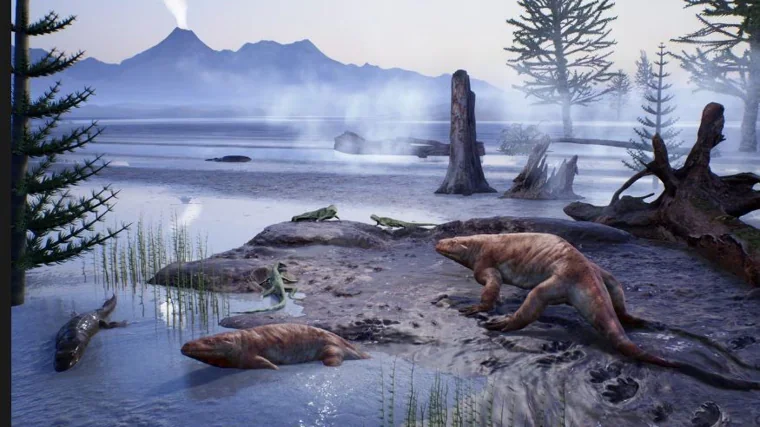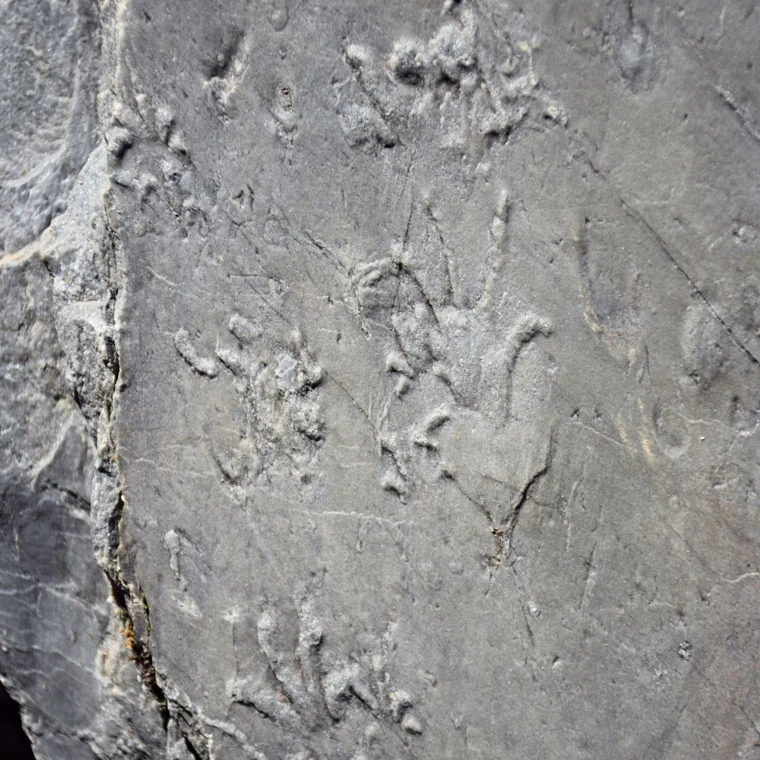It was the hot summer of 2023 when Claudia Steffensen and her husband decided to take a hike through the Italian Alps. They chose the area of Valtellina-Orobie, in Lombardy, near the border with Switzerland, looking for some respite from the high temperatures that devastated Europe. While he guided the way back, Steffensen was attentive, looking at her feet so as not to fall. At one point, he stepped on a strange stone, which looked more like a slab of cement, and had strange marks on it. He got closer and realized that those looked like footprints printed on the rock. He decided to send the photo to his friend Elio Della Ferrera, a naturalist photographer, who took some photos and sent them, in turn, to Cristiano Dal Sasso, a paleontologist at the Museum of Natural History in Milan. They had no idea what a great discovery that serendipity would be.
Dal Sasso and his colleagues discovered something surprising: the tracks belonged to a prehistoric reptile that lived before dinosaurs existed. What’s more: the entire area held signs of an ancient tropical lake that existed about 280 million years ago and that the mud and sediments first, and then the ice, had kept hidden for all this time, until climate change revealed this ancient ecosystem.
Carrying a slab with footprints
Reptiles, amphibians and ancient plant remains
After Steffensen’s discovery in 2023, Della Ferrera and the research team photographed and mapped hundreds of fossil footprints that appeared on the vertical walls of Pizzo del Diavolo di Tenda, Pizzo dell’Omo and Pizzo Rondenino, as well as in nearby landslide accumulations. up to almost 3,000 meters of altitude. They even used a helicopter to look for more traces of this ancient hidden world.
In large stratified blocks of several meters long, row tracks of tetrapods (reptiles and amphibians) and invertebrates (insects and arthropods) have been identified, as well as extinct plants and seeds. Most of these animal and plant species belong to the Permian period, which lasted 254-299 million years ago, the last of the Paleozoic era.
“At that time, dinosaurs did not yet exist, but the authors of the largest footprints found here must have had considerable dimensions, up to 2 or 3 meters in length,” explains Dal Sasso in a release. At this site, footprints of at least five different species of animals (or ichnospecies, since they are traces and not skeletons) have been identified, which will allow detailed paleoecological reconstructions.

Reconstruction of the shores of a lake in the current area of Lombardy
The footprints have endured for so long due to the process in which they were created: animals stepped on the mud and sand on the banks of prehistoric rivers and lakes when they went to drink in them or cool off; At certain times, these shores dried out, so much so that the Sun hardened them almost like cement and the water from the new rains could not erase the marks. In fact, the liquid element did quite the opposite: it protected them by covering them with a thin, new layer of clay.
It was so effective that millions of years later you can even see fine fingers in a row that show how an animal passed through there, tails that dragged themselves snaking through those muds and even marks from the guts of those prehistoric animals that one day, 280 million ago of years, they approached the water.

Close-up of the footprints found
“The very fine texture of the now petrified sediments has allowed the conservation of surprising details, such as impressions of paw pads and the ventral skin of some animals,” explains Lorenzo Marchetti, from the Museum für Naturkunde (Berlin) and one of the researchers who has participated in the work, which has just been made public at a press conference at the Museum of Natural History in Milan. »The quality of preservation and fossil biodiversity observed here probably exceeds that of other sites from the same period in the Orobic and Brescia region«.
The largest mass extinction in history
The Permian period ended with the ‘Great Dying’, the largest mass extinction in recorded history: for some reason that is still not entirely clear (it ranges from the fall of a meteorite to the sudden increase in volcanoes erupting , resulting in an extreme El Niño, among other hypotheses), the world warmed, which caused in a million years – a period that can be compared to a blink in geological times – the disappearance of about 90% of all species on Earth.
It is curious that the traces of that world that became extinct due to extreme heat are now being revealed by the climate change that we are experiencing today: global warming has revealed traces of other ancient living beings with the melting of the permafrost (the always frozen layer of our planet). Without going any further, in the Italian Alps, footprints of a reptile similar to a crocodile have been found at 2,200 meters above sea level.
“The discovery in the Ambria Valley is also an effect of climate change,” says Doriano Codega, president of the Valtellina Orobie natural park. «The exceptional thing was the altitude: these remains were found at very high levels and were very well preserved. This is an area subject to landslides, so there were also rock falls that brought these fossils to light. “This is a very important paleontological discovery.”
#woman #accidentally #discovers #lost #world #million #years

